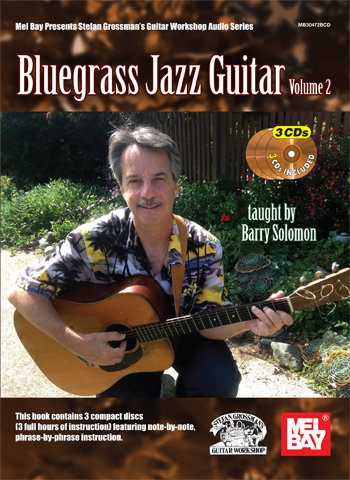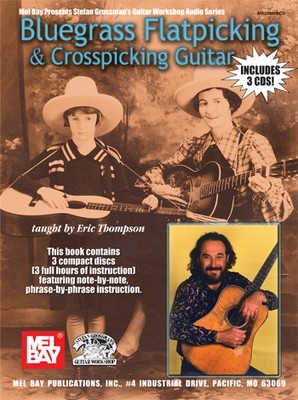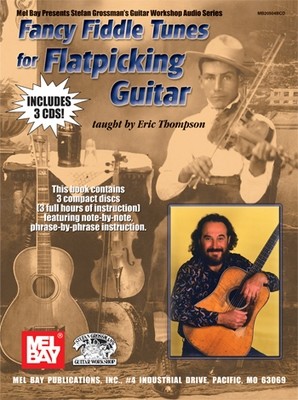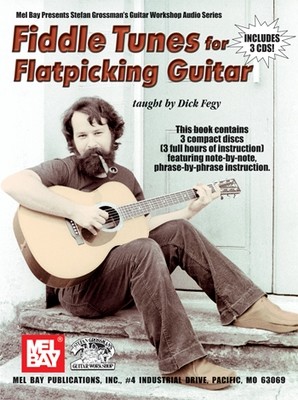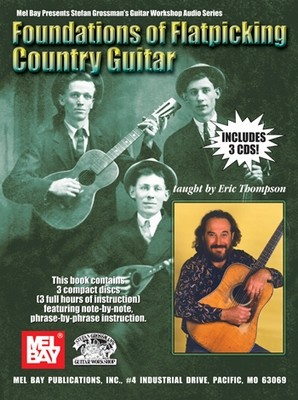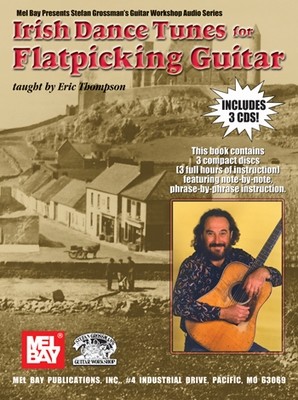
Bluegrass Jazz Guitar Volume Two - 3 CD set taught by Barry Solomon
Flatpicking guitar has taken an interesting journey since its inception, first with Maybelle Carter, then Don Reno, Doc Watson and Clarence White. Younger players who got their start listening to the original masters have melded those influences with other styles, such as Blues, Swing, Classical and even various world music styles.
In this second Volume, Barry Solomon continues his study adding new techniques, improvisational concepts and ideas.
Lesson One: The Way You Look Tonight, All Of Me
Lesson Two: Oh, Baby
Lesson Three: Limehouse Blues
Level 3 • 40 page tab book with three compact discs
Review: For the longest time, jazz and bluegrass music have had parallel paths that often converged. For example, Kenny Baker loved Texas swing and the music of Stephane Grappelli, and various attempts to integrate the styles can be found in the recorded legacies of the likes of David Grisman, Tony Rice, Bela Fleck, Pete Wernick, Buell Neidlinger, and Del McCoury, among others.
Barry Solomon released a wonderful album back in the 1970s called "Southland Sketches," in which he demonstrated how a flatpicking guitarist could maneuver through fiddle tunes and swing standards using the idioms of both styles, aided by the talented Pat Cloud and Sid Page. Solomon's thorough understanding of how to employ bluegrass techniques and integrate them with the more convoluted harmonic and rhythmic possibilities of jazz and swing make him an inspired choice to lead the student through this curriculum.
Over the course of seventy-some pages spread over two volumes and six accompanying CDs, Solomon covers an impressive, almost daunting range of material. Using ten tunes, mostly jazz standards, his distinctive ways of interpreting the melody as a flatpicker and his amazing improvised choruses serve as vehicles to take the student through the complex world of chord extensions and substitutions, syncopated phrasing, rhythmic accompaniment, scale and mode choices, and much much more. The majority of what he plays is represented as tablature, and each song and chorus are painstakingly walked through a segment at a time.
In a way, this book/CD combo functions like one of those some-assembly-required furniture units that have brought greying hair or hair loss to so many of us. There is enough information here, especially insofar as scales are concerned, to give the average learner enough material to chew on for a lifetime. As someone who has dabbled with jazz and swing on a very rudimentary level, I found that Solomon's strength as an instructor is explaining meticulously what scales he uses in certain keys and against certain chord changes. What is dealt with less often - perhaps because it's fodder for an entirely different instructional series or perhaps because it ultimately does come down to an individual player's choices - is why certain phrases were chosen, how to make your breaks "not" sound like you're just riffing off scales. In other words, how to improvise and what it is that makes the inventive and adventurous solos of a player like Solomon sound so much better than the average incessant noodler who thinks in scales, but not in melodies.
Having said that, it should be said that Solomon's playing, teaching, and writing give an ambitious guitarist a strong set of comprehensive tools to help understand some of the fundamental idiosyncrasies of jazz and swing. The only real shortcoming of this package are a few cases of sloppy editing where some contradictions in say the spelling of chords or the use of modes may end up confounding an unfamiliar student already overwhelmed by the subject's complexity. Even something as simple as numbering the measures of the tablatures (something that Solomon references on his CDs, but is not reflected in the final book) might have made things a bit friendlier for the reader. These are just minor quibbles in what is overall a strong, interesting, and important set of teaching materials. Armed with Solomon's considerable know-how and a lot of woodshedding, guitarists can now have a way to bridge the gap between two wonderful and challenging musical forms. – Bluegrass Unlimited
